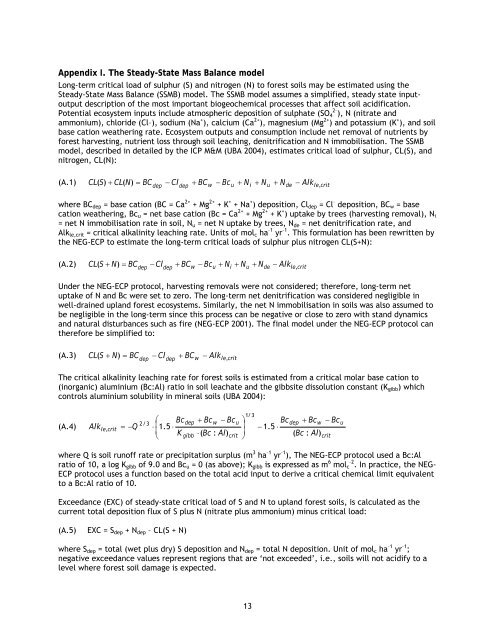calculating critical loads of acid deposition for forest soils in ... - CCME
calculating critical loads of acid deposition for forest soils in ... - CCME
calculating critical loads of acid deposition for forest soils in ... - CCME
You also want an ePaper? Increase the reach of your titles
YUMPU automatically turns print PDFs into web optimized ePapers that Google loves.
Appendix I. The Steady-State Mass Balance model<br />
Long-term <strong>critical</strong> load <strong>of</strong> sulphur (S) and nitrogen (N) to <strong>for</strong>est <strong>soils</strong> may be estimated us<strong>in</strong>g the<br />
Steady-State Mass Balance (SSMB) model. The SSMB model assumes a simplified, steady state <strong>in</strong>putoutput<br />
description <strong>of</strong> the most important biogeochemical processes that affect soil <strong>acid</strong>ification.<br />
Potential ecosystem <strong>in</strong>puts <strong>in</strong>clude atmospheric <strong>deposition</strong> <strong>of</strong> sulphate (SO 4 2– ), N (nitrate and<br />
ammonium), chloride (Cl–), sodium (Na + ), calcium (Ca 2+ ), magnesium (Mg 2+ ) and potassium (K + ), and soil<br />
base cation weather<strong>in</strong>g rate. Ecosystem outputs and consumption <strong>in</strong>clude net removal <strong>of</strong> nutrients by<br />
<strong>for</strong>est harvest<strong>in</strong>g, nutrient loss through soil leach<strong>in</strong>g, denitrification and N immobilisation. The SSMB<br />
model, described <strong>in</strong> detailed by the ICP M&M (UBA 2004), estimates <strong>critical</strong> load <strong>of</strong> sulphur, CL(S), and<br />
nitrogen, CL(N):<br />
(A.1)<br />
CL ( S)<br />
+ CL(<br />
N)<br />
= BCdep<br />
− Cldep<br />
+ BCw<br />
− Bcu<br />
+ Ni<br />
+ Nu<br />
+ Nde<br />
− Alkle,<br />
crit<br />
where BC dep = base cation (BC = Ca 2+ + Mg 2+ + K + + Na + ) <strong>deposition</strong>, Cl dep = Cl – <strong>deposition</strong>, BC w = base<br />
cation weather<strong>in</strong>g, Bc u = net base cation (Bc = Ca 2+ + Mg 2+ + K + ) uptake by trees (harvest<strong>in</strong>g removal), N i<br />
= net N immobilisation rate <strong>in</strong> soil, N u = net N uptake by trees, N de = net denitrification rate, and<br />
Alk le,crit = <strong>critical</strong> alkal<strong>in</strong>ity leach<strong>in</strong>g rate. Units <strong>of</strong> mol c ha –1 yr –1 . This <strong>for</strong>mulation has been rewritten by<br />
the NEG-ECP to estimate the long-term <strong>critical</strong> <strong>loads</strong> <strong>of</strong> sulphur plus nitrogen CL(S+N):<br />
(A.2)<br />
CL ( S + N)<br />
= BCdep<br />
− Cldep<br />
+ BCw<br />
− Bcu<br />
+ Ni<br />
+ Nu<br />
+ Nde<br />
− Alkle,<br />
crit<br />
Under the NEG-ECP protocol, harvest<strong>in</strong>g removals were not considered; there<strong>for</strong>e, long-term net<br />
uptake <strong>of</strong> N and Bc were set to zero. The long-term net denitrification was considered negligible <strong>in</strong><br />
well-dra<strong>in</strong>ed upland <strong>for</strong>est ecosystems. Similarly, the net N immobilisation <strong>in</strong> <strong>soils</strong> was also assumed to<br />
be negligible <strong>in</strong> the long-term s<strong>in</strong>ce this process can be negative or close to zero with stand dynamics<br />
and natural disturbances such as fire (NEG-ECP 2001). The f<strong>in</strong>al model under the NEG-ECP protocol can<br />
there<strong>for</strong>e be simplified to:<br />
(A.3)<br />
CL ( S + N)<br />
= BCdep<br />
− Cldep<br />
+ BCw<br />
− Alkle,<br />
crit<br />
The <strong>critical</strong> alkal<strong>in</strong>ity leach<strong>in</strong>g rate <strong>for</strong> <strong>for</strong>est <strong>soils</strong> is estimated from a <strong>critical</strong> molar base cation to<br />
(<strong>in</strong>organic) alum<strong>in</strong>ium (Bc:Al) ratio <strong>in</strong> soil leachate and the gibbsite dissolution constant (K gibb ) which<br />
controls alum<strong>in</strong>ium solubility <strong>in</strong> m<strong>in</strong>eral <strong>soils</strong> (UBA 2004):<br />
(A.4)<br />
Alk<br />
le,<br />
crit<br />
= −Q<br />
2/3<br />
⎛ Bc<br />
⋅ ⎜1.5<br />
⋅<br />
⎝<br />
K<br />
dep<br />
gibb<br />
+ Bc<br />
w<br />
− Bc<br />
⋅(<br />
Bc : Al)<br />
u<br />
crit<br />
⎞<br />
⎟<br />
⎠<br />
1/3<br />
Bc<br />
− 1.5 ⋅<br />
dep<br />
+ Bc<br />
w<br />
( Bc : Al)<br />
− Bc<br />
crit<br />
u<br />
where Q is soil run<strong>of</strong>f rate or precipitation surplus (m 3 ha –1 yr –1 ), The NEG-ECP protocol used a Bc:Al<br />
ratio <strong>of</strong> 10, a log K gibb <strong>of</strong> 9.0 and Bc u = 0 (as above); K gibb is expressed as m 6 mol c –2 . In practice, the NEG-<br />
ECP protocol uses a function based on the total <strong>acid</strong> <strong>in</strong>put to derive a <strong>critical</strong> chemical limit equivalent<br />
to a Bc:Al ratio <strong>of</strong> 10.<br />
Exceedance (EXC) <strong>of</strong> steady-state <strong>critical</strong> load <strong>of</strong> S and N to upland <strong>for</strong>est <strong>soils</strong>, is calculated as the<br />
current total <strong>deposition</strong> flux <strong>of</strong> S plus N (nitrate plus ammonium) m<strong>in</strong>us <strong>critical</strong> load:<br />
(A.5) EXC = S dep + N dep – CL(S + N)<br />
where S dep = total (wet plus dry) S <strong>deposition</strong> and N dep = total N <strong>deposition</strong>. Unit <strong>of</strong> mol c ha –1 yr –1 ;<br />
negative exceedance values represent regions that are ‘not exceeded’, i.e., <strong>soils</strong> will not <strong>acid</strong>ify to a<br />
level where <strong>for</strong>est soil damage is expected.<br />
13
















